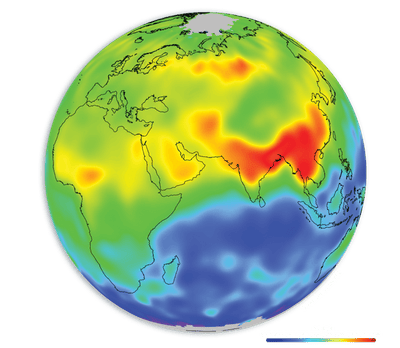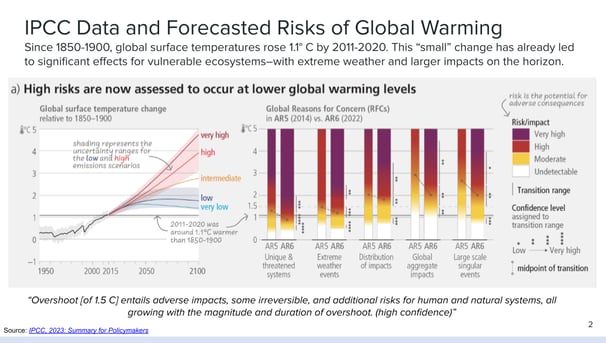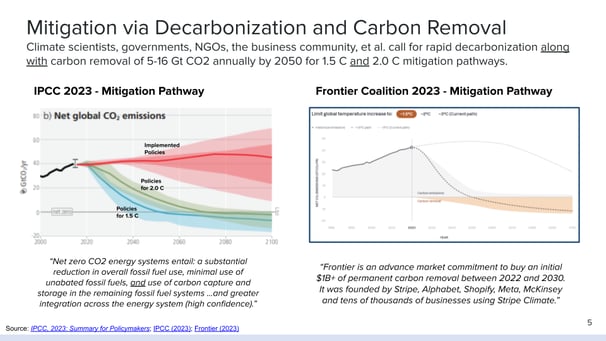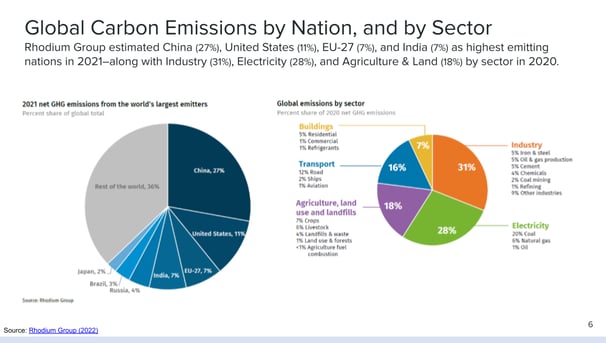Climate Science
Overview of Climate Change and Net-Zero Pathways
CLEAN ENERGY & CLIMATE
Drew Hooper
10/11/20233 min read


Climate Science
The UN-established Intergovernmental Panel on Climate Change (IPCC), Global Carbon Project, World Climate Research Programme, and Great Plains Institute constitute but a few of the client science research organizations, largely supported by the science community, governments, business leaders, and public interest groups. The leading organizations concur that climate change is all but fully attributable to human activities, foremost being those which emit greenhouse gasses. Relative to 1750 pre-industrial levels, global atmospheric CO2 has risen 50% to ~417 ppm. And relative to 1850-1900, average global surface temperature has risen 1.1°C.
Impacts of Global Warming
Effects of climate change vary by region, ecosystem, and population–vulnerable regions have already begun to experience adverse impacts (e.g. coral reefs, biodiversity hotspots, the Arctic) and exacerbated weather (e.g. coastline communities, island nations, arid agrarian-reliant populations). Temperature rise to 1.5°C or 2.0°C correlates with greater risks of general damages–from weather-related storms, to loss of species, and health and food production detractors. Climate science experts estimate a budget for global carbon emissions of some 150-350 Gt CO2-equivalent emissions remain until the world will have warmed by 1.5°C (and 400-680 Gt CO2e until 2.0°C). In 2022, global CO2e emissions totaled ~40.5 Gt, an increase of more than 1% from 2021 levels.
Image Source: European Space Agency
Net Zero Mitigation Pathways
World leaders have analyzed and recommended “mitigation pathways” to transitioning from carbon-emitting to “net-zero” activities, as well as actions to restore climate health. All of these mitigation plans call for rapid “decarbonization”–including to transition energy, transportation, industrial processes, agriculture, etc. to clean alternatives. At COP21 in 2015, 196 national parties signed the UNFCCC Paris Agreement committing to limit global temperature change to 2.0°C in this century and make efforts toward 1.5°C change--targeting that global emissions peak before 2025 and decrease 43% by 2030. Ambitious net-zero scenarios call for decarbonization with significant reduction milestones for 2030 and 2050. While more depressed scenarios incorporate delays and disruptions with increased damages.
Global Emissions Tracking
Coordinating and implementing decarbonization across the world’s nations and sectors constitutes one of the greatest challenges of our time. The Rhodium Group estimated the highest emitting nations in 2021 as: China (27%), United States (11%), EU-27 (7%), India (7%), and only three other nations contributing more than 3% each. Similarly, the Rhodium Group estimated emissions by sector for 2020 as: Industry (31%), Electricity (28%), Agriculture & Land (18%), Transportation (16%), and Buildings (7%). As of 2023, 97 UNFCCC nation parties have at least politically pledged to net-zero or carbon neutrality by 2100–which represent ~82% of global emissions. Of these, 16 have enacted their pledges into laws (18% of global emissions) and 54 have policies drafted to do so (61% of global emissions).
Need for Carbon Removal
Alongside rapid decarbonization, the climate science community, government, NGOs, and business leaders have concurred on the need to scale up “carbon removal” from the atmosphere, through both nature-based and technological solutions. The IPCC foremost estimated a need to scale up to 5-16 Gt CO2e in annual carbon removal by 2050. “Advance market commitment” coalitions to buy carbon removal have emerged from private and NGO associations. Two foremost include the Frontier Coalition (Stripe, Alphabet, McKinsey & Co., et al. with $1B pledged) and First Movers Coalition (WEF and 113 member organizations, with over $12B pledged).
Carbon Markets
Moreover, carbon markets have emerged as economic mechanisms for nations, organizations, and individuals to sell and buy carbon removal credits. Compliance-oriented carbon markets prescribe reduction plans with annual emissions allowances for member localities or organizations. Voluntary carbon markets provide verified carbon removal for purchase. Morgan Stanley sized the market for voluntary carbon offsets/removals at $100B by 2030 and $250B by 2050.
Climate & Sustainability Corporate Reporting
Climate impact and other sustainability practices have become “material” concerns for corporations, shareholders and investors, and the public. Various protocols have emerged in recent decades in efforts to standardize public disclosure of climate impact and other sustainability metrics. In July 2023, the COP-26-established ISSB or sustainability arm of International Financial Reporting Standards (IFRS) collaboratively published two new standards, which have potential to become the global industry standard.






